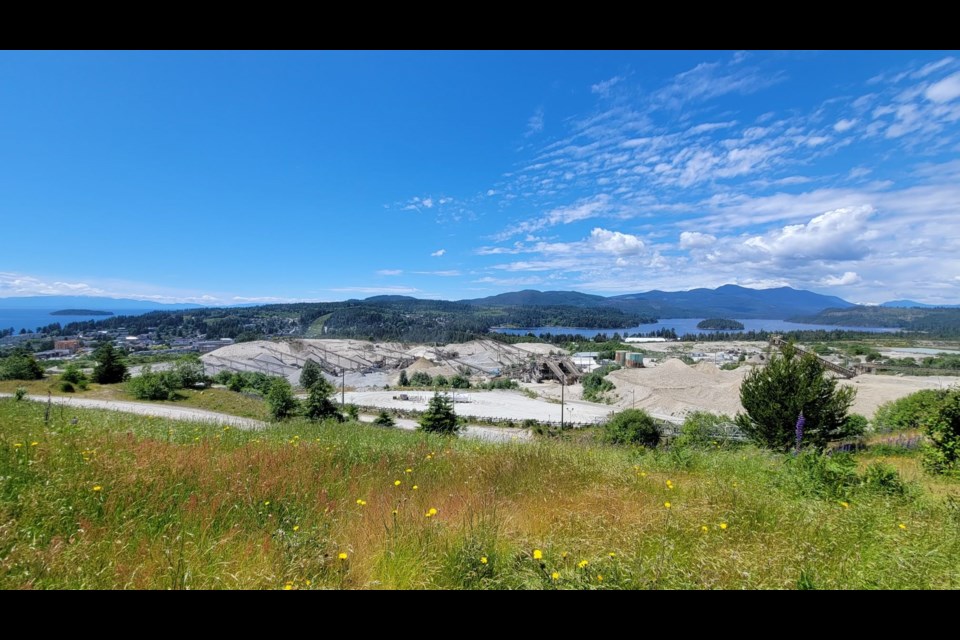shíshálh Nation is putting forward a possible solution to the Sunshine Coast’s ongoing water crisis: building two reservoirs for large-scale water storage.
shíshálh Nation hosted the latest water summit between local governments of the Sunshine Coast on May 25, and announced its proposal the next day in a press release.
“The main thing we took from our partners’ contributions at the Summits is that we cannot wait — this spring has made it very clear,” shíshálh Nation hewhius (councillor) Rochelle Jones said in the release. “We need water storage facilities.”
She said shíshálh has proposed not one but two reservoirs to federal, provincial and local governments as well as corporate partners.
“We are actively working on advanced studies for water storage areas on shíshálh lands within the current Heidelberg Materials site,” Jones said, adding that “time is of the essence.” (Lehigh Hanson Materials changed its brand to Heidelberg Materials earlier this year.)
lhe hiwus yalxwemult (Chief Lenora Joe) said the reservoirs will be used to store naturally occurring drinking water for summer months. Two separate sites are being considered for a total capacity of nearly 3 million cubed metres of water: 800,000 m3 at one site and 2.1 million m3 at the second.
“Our goal is to have the first reservoir ready by 2024 and the second one by 2027-28,” yalxwemult said. First they’ll need to secure the funding and have more meeting with other local governments.
Visit to Ottawa
In a recent trip to Ottawa, yalxwemult met with Prime Minister Justin Trudeau and Marc Miller, the Minister of Crown–Indigenous Relations Canada, to share some of shíshálh Nation’s priorities and concerns. During those meetings, water was identified as one of their main concerns. yalxwemult said she received a supportive response from Miller and Trudeau, who are willing to meet to discuss what kind of funding might be available for the project.
The federal politicians asked whether shíshálh Nation is collaborating with other local governments on the Coast, to which yalxwemult assured them is the case. The collaborating governments are taking their proposed projects into consideration to submit one application form to senior governments, she said.
The proposal comes on the heels of a record-breaking drought and states of local emergency the lower Sunshine Coast experienced in 2022. After the long period without rainfall, and precipitation became snow, the lakes did not refill at anticipated speeds. Now, as water restrictions begin ahead of the summer season, local governments have been meeting to urgently find solutions for water supply.
The idea of a reservoir on shíshálh Nation land has been on the table for a number of years, yalxwelmult said, and was raised in 2007 and maybe earlier.
“We were able to review some documents from our ancestors from 1860, when they chose this location to have our summer homes here, yalxwemult said. “They recognized the biggest issue they said that they had was water, how are they going to ensure that our people had water.
“Isn’t that interesting? How many years later, we’re still discussing that. “
A growth strategy
Another action is a sustainable growth strategy being developed with shíshálh Nation, Sḵwx̱wú7mesh Úxwumixw (Squamish Nation), the Sunshine Coast Regional District (SCRD), District of Sechelt and Town of Gibsons to help manage water challenges into the future.
“Water is sacred to the shíshálh people. It is a finite and precious resource — that has become starkly visible in the last few years,” yalxwemult said in the press release. “Our ancestors predicted many generations ago that water would become the most precious and limited resource of our time. They warned us to be thoughtful and careful about how water is used.”
shíshálh Nation will share more information with all of the residents of its swiya (territory, or world) as dialogue continues with the provincial and federal governments.



